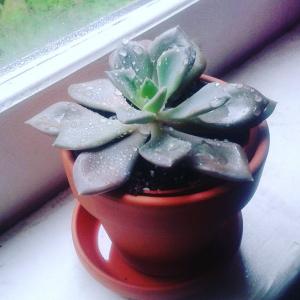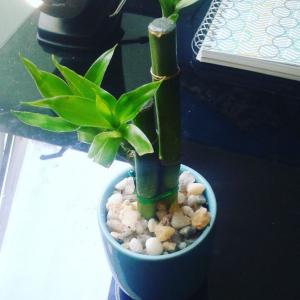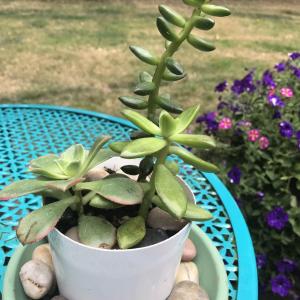文章
Dummer. ゛☀
2017年08月21日

If you’re looking to increase your collection of houseplants without spending any money, propagating spiderettes, (spider plant babies), from an existing plant is as easy as it gets. Even kids or brand new gardeners can easily learn how to root spider plantlets. Read on to learn more about propagating your spider plants.
Spider Plant Propagation
When you’re ready to propagate your spider plant babies, you have the option of rooting the plantlets by growing directly in soil or you can choose to root them in water.
Growing Plantlets from Spider Plants
There are a couple of ways to plant spider plant babies, and they’re both easy peasy. Look closely at the spiderettes dangling from your adult plant and you’ll see little knob-like protrusions and tiny roots on the bottom of each spiderette. Spider plant propagation simply involves planting the spiderette in a pot filled with any lightweight potting mix. Be sure the pot has drainage holes in the bottom. You can leave the baby attached to the parent plant until the new plant takes root, then separate it from the parent by snipping the runner. Alternatively, go ahead and separate the baby from the parent plant by snipping the runner immediately. Spiderettes will root easily either way, but if you have a hanging spider plant, the latter is the best way to go.
How to Root Spider Plantlets in Water
Planting spiderettes in potting soil is the easiest and quickest way to propagate spider plant babies. However, if you like, you can stick the spiderette in a glass of water for a week or two, then plant the rooted spiderette in a pot of soil. This is an unnecessary step, but some people enjoy rooting a new plant the old-fashioned way – in a jar on the kitchen windowsill.
Caring for Spider Plant Babies
If you want a thick, bushy plant, start several spider plant babies in the same pot. Similarly, if your adult spider plant isn’t as full as you would like, plant a couple of spiderettes alongside the mama plant. Water the fledgling spider babies as needed to keep the soil slightly moist, but never saturated, until healthy new growth indicates the plant has rooted. Your new spider plant is well on its way, and you can resume normal care.

Spider Plant Propagation
When you’re ready to propagate your spider plant babies, you have the option of rooting the plantlets by growing directly in soil or you can choose to root them in water.
Growing Plantlets from Spider Plants
There are a couple of ways to plant spider plant babies, and they’re both easy peasy. Look closely at the spiderettes dangling from your adult plant and you’ll see little knob-like protrusions and tiny roots on the bottom of each spiderette. Spider plant propagation simply involves planting the spiderette in a pot filled with any lightweight potting mix. Be sure the pot has drainage holes in the bottom. You can leave the baby attached to the parent plant until the new plant takes root, then separate it from the parent by snipping the runner. Alternatively, go ahead and separate the baby from the parent plant by snipping the runner immediately. Spiderettes will root easily either way, but if you have a hanging spider plant, the latter is the best way to go.

How to Root Spider Plantlets in Water
Planting spiderettes in potting soil is the easiest and quickest way to propagate spider plant babies. However, if you like, you can stick the spiderette in a glass of water for a week or two, then plant the rooted spiderette in a pot of soil. This is an unnecessary step, but some people enjoy rooting a new plant the old-fashioned way – in a jar on the kitchen windowsill.

Caring for Spider Plant Babies
If you want a thick, bushy plant, start several spider plant babies in the same pot. Similarly, if your adult spider plant isn’t as full as you would like, plant a couple of spiderettes alongside the mama plant. Water the fledgling spider babies as needed to keep the soil slightly moist, but never saturated, until healthy new growth indicates the plant has rooted. Your new spider plant is well on its way, and you can resume normal care.
0
0
Michele Ondra:Thanks! I’ve been wondering how to do this.
文章
Dummer. ゛☀
2017年08月20日

Schefflera is a common house and office plant. This tropical plant is native to Australia, New Guinea and Java, where it is an understory plant. The exotic foliage and epiphytic nature of the plant make it an interesting specimen to grow in warm season gardens. Can Schefflera plants grow outside? Sadly, the plant is not reliably hardy below United States Department of Agriculture zones 10 and 11, but it will make an interesting container specimen that can be moved indoors.
Growing Schefflera Plants Outdoors
When the sun is shining, it is tempting to mimic some of our favorite tropical vacation spots in our landscapes. Adding tropical flair to the garden evokes the sights and sounds of a sultry, humid rainforest in an exotic locale. If you live in an appropriate zone, you can grow Shefflera outdoors year round.
Outdoor Schefflera care differs somewhat from indoor plant maintenance. Plants can get bigger in ground and may need supplemental support and nutrition as well as a regular watering schedule, but Schefflera plant care outside is low maintenance compared to many landscape plants. Choose a location with partial to full shade or even full sun when growing Schefflera plants outdoors. Incorporate plenty of well-rotted compost, leaf litter or other organic amendments. Remember, in its native range the plant would be growing in the humus rich soil that is nurtured by a constant supply of over story leaves, animal droppings and constant moisture. It is necessary to duplicate that rich soil as much as you can for best Schefflera growth.
Apparently, some Schefflera plants can tolerate zone 9b but will require a sheltered location, and in ground plants may die back. In other zones, you can use Schefflera as an annual foliage plant or keep it in a container and move indoors if cold temperatures arrive. Schefflera plants are common in southern California, Florida, and in places like Phoenix. The plants need a high humidity environment to produce the bright red flowers, so most regions cannot expect blooms, but the attractive foliage will provide a tropical foil for other plants.
Care for Outdoor Schefflera Plants
Schefflera plant care outside is not a lot different from indoor houseplant care. Over time, the tree will drop its leaves as it produces new ones. These take quite a while to break down and should be moved away from the root zone so insects and pests don’t have a convenient hiding place. Plants tend to dry out more quickly and they are more exposed to pests and diseases. Keep your Schefflera moderately moist and watch for mealybugs, scale, aphids, and spider mites. Keep the leaves rinsed free of dust and debris. Staking or support may be required for good care for outdoor Schefflera plants. Be careful where you install Shefflera, as the roots are dense and strong and can damage driveways and foundations over time. For good outdoor Schefflera care, some gardeners recommend topping the plant when it grows tall. This forces it to produce a denser form and branching. If your plant gets flowers, you may want to remove them in areas such as Florida, where the plant easily naturalizes itself. Simply remove the flowers before seed is mature. With a little protection and forethought, Schefflera can make an excellent addition to the landscape for years.

Growing Schefflera Plants Outdoors
When the sun is shining, it is tempting to mimic some of our favorite tropical vacation spots in our landscapes. Adding tropical flair to the garden evokes the sights and sounds of a sultry, humid rainforest in an exotic locale. If you live in an appropriate zone, you can grow Shefflera outdoors year round.
Outdoor Schefflera care differs somewhat from indoor plant maintenance. Plants can get bigger in ground and may need supplemental support and nutrition as well as a regular watering schedule, but Schefflera plant care outside is low maintenance compared to many landscape plants. Choose a location with partial to full shade or even full sun when growing Schefflera plants outdoors. Incorporate plenty of well-rotted compost, leaf litter or other organic amendments. Remember, in its native range the plant would be growing in the humus rich soil that is nurtured by a constant supply of over story leaves, animal droppings and constant moisture. It is necessary to duplicate that rich soil as much as you can for best Schefflera growth.

Apparently, some Schefflera plants can tolerate zone 9b but will require a sheltered location, and in ground plants may die back. In other zones, you can use Schefflera as an annual foliage plant or keep it in a container and move indoors if cold temperatures arrive. Schefflera plants are common in southern California, Florida, and in places like Phoenix. The plants need a high humidity environment to produce the bright red flowers, so most regions cannot expect blooms, but the attractive foliage will provide a tropical foil for other plants.

Care for Outdoor Schefflera Plants
Schefflera plant care outside is not a lot different from indoor houseplant care. Over time, the tree will drop its leaves as it produces new ones. These take quite a while to break down and should be moved away from the root zone so insects and pests don’t have a convenient hiding place. Plants tend to dry out more quickly and they are more exposed to pests and diseases. Keep your Schefflera moderately moist and watch for mealybugs, scale, aphids, and spider mites. Keep the leaves rinsed free of dust and debris. Staking or support may be required for good care for outdoor Schefflera plants. Be careful where you install Shefflera, as the roots are dense and strong and can damage driveways and foundations over time. For good outdoor Schefflera care, some gardeners recommend topping the plant when it grows tall. This forces it to produce a denser form and branching. If your plant gets flowers, you may want to remove them in areas such as Florida, where the plant easily naturalizes itself. Simply remove the flowers before seed is mature. With a little protection and forethought, Schefflera can make an excellent addition to the landscape for years.
0
0





















